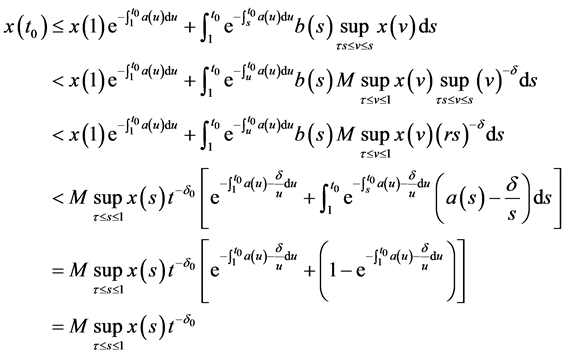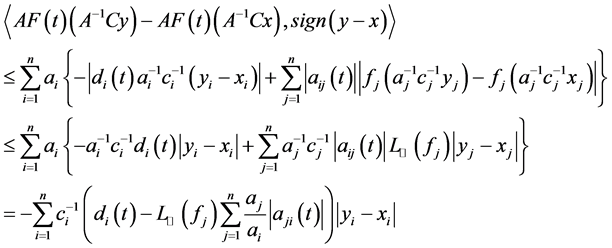Advances in Applied Mathematics
Vol.05 No.04(2016), Article ID:19069,11
pages
10.12677/AAM.2016.54082
An Average Criterion for Global Asymptotic Stability of Periodic Multi-Proportional Delayed Cellular Neural Networks
Xiaowei Wang, Jifang Hu, Yuzhu Xiao, Xueli Song*
College of Science, Chang’an University, Xi’an Shaanxi

Received: Nov. 5th, 2016; accepted: Nov. 19th, 2016; published: Nov. 28th, 2016
Copyright © 2016 by authors and Hans Publishers Inc.
This work is licensed under the Creative Commons Attribution International License (CC BY).
http://creativecommons.org/licenses/by/4.0/



ABSTRACT
This paper is devoted to studying global asymptotic stability of cellular neural networks with periodic coefficients and multi-proportional delays. Firstly, through studying the asymptotic stability of the differential inequality, we give the asymptotic stability criterion of a class of periodic functional differential equations. Secondly, we obtain an integral average criterion for global asymptotic stability of the cellular neural networks by means of the result we obtain and the nonlinear measure method, and our study result is partial generalization of some existing results. Finally, we use an example to illustrate the correctness of our result.
Keywords:Global Asymptotic Stability, Cellular Neural Networks, Periodic Coefficients, Multi-Proportional Delays, Integral Average Criterion

周期多比例时滞细胞神经网络全局渐近稳定性的平均准则
王小伟,胡霁芳,肖玉柱,宋学力*
长安大学理学院,陕西 西安

收稿日期:2016年11月5日;录用日期:2016年11月19日;发布日期:2016年11月28日

摘 要
本文致力于研究带有周期系数和多比例时滞细胞神经网络的全局渐近稳定性。首先,通过研究微分不等式的渐近稳定性,我们给出一类周期泛函微分方程的渐近稳定性准则;其次,利用获得的稳定性结果和非线性测度方法,我们给出该类神经网络的全局渐近稳定性准则,我们的研究结果是现有相关结果的部分推广;最后,一个例子被提供以说明我们结果的正确性。
关键词 :全局渐近稳定性,细胞神经网络,周期系数,多比例时滞,积分平均准则

1. 引言
因为Chua和Yang在 [1] [2] 中引入的细胞神经网络的特点是细胞之间的局部连接性,输出函数的分段线性和信号处理的连续实时性,所以它具有易于大规模集成电路实现,高速并行处理等优点。目前该网络已经被成功地应用于优化问题、模式识别、生物学和图像处理等领域 [3] 。稳定性是神经网络成功应用于实际问题的前提,但是信号传输以及使用电子器都会导致系统产生时滞 [4] ,这会破坏系统的稳定性。许多实际问题中出现了比例时滞的情况 [5] [6] [7] [8] [9] 。相对于一般的时滞,比例时滞问题更难处理,因为这类时滞是无界时变的 [10] 。在 [10] [11] [12] [13] 中已经得到一些比例时滞细胞神经网络的稳定性准则。在动力学中,周期性振荡常常出现在非自治的神经网络中 [14] 。人类大脑的网络通常表现出周期性振荡性,它可以代表各种存储或记忆模式 [15] 。近年来,关于非自治细胞神经网络的周期性振荡有许多优秀的结果 [15] - [23] 。然而还没有发现对带有周期系数和多比例时滞的细胞神经网络的稳定性研究结果。文献 [24] 针对时滞周期微分不等式给出了一种积分平均准则,并且这个准则已成功地被用来研究周期细胞神经网络的全局指数稳定性 [16] [25] 。受此启发,本文致力于研究带有周期系数和多比例时滞细胞神经网络的全局渐近稳定性,部分推广现有的细胞神经网络稳定性的研究结果。
2. 模型描述
考虑下面带有周期系数和多比例时滞细胞神经网络模型:
 (1)
(1)
其中, 表示网络中神经元的个数;
表示网络中神经元的个数; 表示第
表示第 个神经元在
个神经元在 时刻的状态;
时刻的状态; 是周期为
是周期为 的连续函数,表示衰减率;
的连续函数,表示衰减率; ,
, ,
, 和
和 也是周期为
也是周期为 的连续函数,
的连续函数, 表示外部输入;
表示外部输入; 和
和 表示比例时滞因子,并且满足
表示比例时滞因子,并且满足 ,
, ,当
,当 时,有
时,有 ,
, ;
; ,
, 和
和 表示非线性激活函数。
表示非线性激活函数。
为了研究模型(1)的稳定性,我们做如下假设:
(H)激活函数 ,
, 和
和 在
在 上全局Lipschitz连续,其中
上全局Lipschitz连续,其中 。
。
3. 预备知识
 维向量空间
维向量空间 被赋予
被赋予 ,其定义为
,其定义为 ,其中
,其中 。为了刻画模型(1)的稳定性,我们先考虑下面比例时滞周期泛函微分方程
。为了刻画模型(1)的稳定性,我们先考虑下面比例时滞周期泛函微分方程
 (2)
(2)
其中, 表示所有从
表示所有从 到
到 的连续函数的集合,
的连续函数的集合, 是Lipschitz连续的非线性周期算子,
是Lipschitz连续的非线性周期算子, 为
为 的开子集。
的开子集。
定义1. [26] 如果存在一个和 有关的常数
有关的常数 使得非线性算子
使得非线性算子 满足
满足
 ,
,
则称 在
在 上Lipschitz连续,
上Lipschitz连续, 称为
称为 的Lipschiz常数。常数
的Lipschiz常数。常数

叫做 在
在 上的最小Lipschiz常数。
上的最小Lipschiz常数。
定义2. [27]  是一个非线性算子,称与
是一个非线性算子,称与 有关的常数
有关的常数

为 在
在 上的非线性测度。
上的非线性测度。
定义3. [24] 如果 是周期为
是周期为 的连续函数,那么常数
的连续函数,那么常数

叫做 的积分平均值。
的积分平均值。
为了得到方程(2)的稳定性,我们先研究下面的微分不等式的稳定性
 (3)
(3)
其中, 和
和 是周期为
是周期为 的连续函数,并且
的连续函数,并且 。
。
引理1. 如果 ,则微分不等式(3)是渐近稳定的,并且有
,则微分不等式(3)是渐近稳定的,并且有
 , (4)
, (4)
其中 ,
, ,
, 为方程
为方程 的根。
的根。
证明:令 ,其中
,其中 ,我们有
,我们有 ,
, 。因此方程
。因此方程 有唯一的正实数根。因此
有唯一的正实数根。因此 。显然,当
。显然,当 时
时 成立。假设当
成立。假设当 时(4)式不成立,那么一定存在一点
时(4)式不成立,那么一定存在一点 ,满足当
,满足当 时有
时有 ,并且
,并且 。从(3)式我们可以得到:
。从(3)式我们可以得到:
 。
。
这与 矛盾。所以(4)式成立,即微分不等式(3)是渐近稳定的。
矛盾。所以(4)式成立,即微分不等式(3)是渐近稳定的。
引理2. 如果 成立,其中
成立,其中 ,
, ,那么微分不等式(3)是渐近稳定的,并且存在
,那么微分不等式(3)是渐近稳定的,并且存在 使(4)式成立,其中
使(4)式成立,其中 为方程
为方程
 (5)
(5)
的根, 。
。
证明:令 ,我们有
,我们有 ,并且对任意的
,并且对任意的 ,有
,有 。所以,
。所以,
 。
。
因为 ,由引理1可知,存在
,由引理1可知,存在 ,使
,使
 。
。
其中 ,
, 是方程
是方程 的根。 假设
的根。 假设 在
在 时取得最小值,即
时取得最小值,即 ,并且我们有
,并且我们有
 。 (6)
。 (6)
假设 ,比较(5)和(6)我们可以得到
,比较(5)和(6)我们可以得到
 。
。
发生矛盾,因此 。也就是说
。也就是说 在
在 最小时取得最小值。那么
最小时取得最小值。那么
 。
。
所以, ,其中
,其中 。
。
注1:和 [28] 中的Halanay不等式比较,我们不再要求 对每个
对每个 都成立,仅需验证
都成立,仅需验证 成立,即可得到该微分不等式的渐近稳定性。此外,我们还估计出了收敛速度,丰富和完善了微分不等式的现有稳定性理论。
成立,即可得到该微分不等式的渐近稳定性。此外,我们还估计出了收敛速度,丰富和完善了微分不等式的现有稳定性理论。
定理1. 如果存在对角矩阵 ,使
,使
 (7)
(7)
成立,其中
 ,
,
那么泛函微分方程(2)是渐近稳定的。特别地,如果 ,
, 是方程(2)初值分别为
是方程(2)初值分别为 的解,那么存在
的解,那么存在 使得
使得 ,
, 满足
满足
 。 (8)
。 (8)
其中 为方程
为方程
 (9)
(9)
的根, 。
。
证明:令 ,可得
,可得
 。
。
由引理2以及条件(7)可得
 。 (10)
。 (10)
也就是(8)式成立。
4. 主要结果
为了研究模型(1)的全局渐近稳定性,令 和
和 ,其中,
,其中, ,
,
 。
。
定理2. 假设(H)成立,并且存在 使
使
 ,(11)
,(11)
其中 ,
, 是系数
是系数 和
和 的周期,
的周期,
 ,
,
 。
。
那么模型(1)是全局渐近稳定的。也就是说,如果 ,
, 为模型(1)初值为
为模型(1)初值为 的解,那么存在
的解,那么存在 使得
使得 ,
, 满足
满足
 , (12)
, (12)
其中 为方程
为方程
 (13)
(13)
的根,并且
 。
。
证明:令 ,
, 。 那么,对所有的
。 那么,对所有的 ,
,
 。
。
从而
 。
。
因此 。
。
 ,
,
可以得到
 。
。
所以
 。
。
因此
 。
。
不失一般性,我们可以假定 在
在 时取得最大值,也就是
时取得最大值,也就是
 。
。
由于 ,故
,故
 。
。
从不等式(11)可以得到
 。
。
根据定理1可知,如果 ,
, 是初值于
是初值于 的下面泛函微分方程的解
的下面泛函微分方程的解
 (14)
(14)
那么
 。
。
如果 ,
, 是模型(1)的解,那么
是模型(1)的解,那么 和
和 就是微分方程(14)的解。因此模型(1)是全局渐近稳定的,并且有(12)式成立。
就是微分方程(14)的解。因此模型(1)是全局渐近稳定的,并且有(12)式成立。
注2:定理2给出了带有周期系数和多比例时滞细胞神经网络全局渐近稳定性的一个平均准则。和文献 [10] 研究的多比例时滞细胞神经网络全局渐近稳定性相比,我们的模型是非自治的,我们的模型和研究结果是 [10] 的非自治推广。文献 [25] 处理了常数时滞的细胞神经网络模型的稳定性,与之相比,我们处理的是比例时滞,即无穷时滞,所以我们的研究内容是新的。
5. 数值算例
例:考虑下面的细胞神经网络
 (15)
(15)
其中 ,和
,和 ,
,
 ,
,
 。
。
很容易得到 ,
, ,
, ,
, ,
, 。
。
取 ,
, ,通过计算有
,通过计算有 ,
, ,
, ,故
,故

因此,如果 ,
, 为网络(15)的解,那么分别初值于
为网络(15)的解,那么分别初值于 和
和 的解
的解 ,
, 满足
满足
 。
。
其中 为方程
为方程

的根。细胞神经网络(15)的解的模拟见图1。
6. 结论
本文对带有多比例时滞周期细胞神经网络的全局渐近稳定进行了研究。我们分别获得了微分不等式的两个渐近稳定性准则,抽象非自治比例时滞泛函微分方程和周期多比例时滞细胞神经网络的渐近稳定性准则,丰富和完善了现有的稳定性结果。

Figure 1. Simulation of cellular neural network (15)
图1. 细胞神经网络(15)解的模拟仿真
致谢
本文得到国家自然科学基金(11201038),陕西省青年科技新星项目(2014KJXX-55),长安大学中央高校基本科研业务费专项资金(310812163504,310812151004)的资助。
文章引用
王小伟,胡霁芳,肖玉柱,宋学力. 周期多比例时滞细胞神经网络全局渐近稳定性的平均准则
An Average Criterion for Global Asymptotic Stability of Periodic Multi-Proportional Delayed Cellular Neural Networks[J]. 应用数学进展, 2016, 05(04): 705-715. http://dx.doi.org/10.12677/AAM.2016.54082
参考文献 (References)
- 1. Chua, L.O. and Yang, L. (1988) Cellular Neural Network: Theory. IEEE Transactions on Circuits and System, 35, 1257-1272. https://doi.org/10.1109/31.7600
- 2. Chua, L.O. and Yang, L. (1988) Cellular Neural Network: Applications. IEEE Transactions on Circuits and System, 35, 1273-1290. https://doi.org/10.1109/31.7601
- 3. Civalleri, P.P., Gilli, M. and Pandolfi, L. (1993) On Stability of Cellular Neural Networks with Delay. IEEE Transactions on Circuits and Systems, I. Regular Papers, 40, 157-164. https://doi.org/10.1109/81.222796
- 4. Chen, W.H. and Zheng, W.X. (2010) A New Method for Complete Stability Analysis of Cellular Neural Networks with Time Delay. IEEE Transactions on Neural Networks, 21, 1126-1138. https://doi.org/10.1109/TNN.2010.2048925
- 5. Ockendon, J.R. and Tayler, A.B. (1971) The Dynamics of a Current Collection System for an Electric Locomotive. Proceedings of the Royal Society A, 322, 447-468. https://doi.org/10.1098/rspa.1971.0078
- 6. Fox, L., Mayers, D.F., Ockendon, J.R. and Tayler, A.B. (1971) On a Functional-differential Equation. Journal of the Institute of Mathematics and Its Applications, 8, 271-307. https://doi.org/10.1093/imamat/8.3.271
- 7. Derfel, G.A. (1982) On the Behavior of the Solutions of Functional and Functional-differential Equations with Several Deviating Arguments. Ukrainian Mathematical Journal, 34, 286-291. https://doi.org/10.1007/BF01682121
- 8. Derfel, G.A. (1990) Kato Problem for Functional-Differential Equations and Difference Schrodinger Operators. Operator Theory, 46, 319-321. https://doi.org/10.1007/978-3-0348-7306-2_31
- 9. Tan, M. (2006) Feedback Stabilization of Linear Systems with Proportional Time Delay. Information and Control, 35, 690-694.
- 10. Song, X.L., Zhao, P., Xing, Z.W. and Peng, J.G. (2016) Global Asymptotic Stability of CNNs with Impulses and Multi-proportional Delays. Mathematical Methods in the Applied Science, 39, 722-733. https://doi.org/10.1002/mma.3515
- 11. Zhang, Y.Y. and Zhou, L.Q. (2012) Exponential Stability of a Class of Cellular Neural Networks with Multi-Panto- graph Delays. Acta Electronica Sinica, 40, 1159-1163.
- 12. Zhou, L.Q. (2013) Delay-Dependent Exponential Stability of Cellular Neural Networks with Multi-Proportional Delays. Neural Processing Letters, 38, 347-359. https://doi.org/10.1007/s11063-012-9271-8
- 13. Zhou, L.Q. and Liu, J.R. (2013) Global Asymptotic Stability of a Class of Cellular Neural Networks with Proportional Delays. Chinese Journal of Engineering Mathematics, 5, 673-682.
- 14. Gopalsamy, K. (1992) Stability and Oscillations in Delay Differential Equations of Populations Dynamics. Kluwer, Dordrecht. https://doi.org/10.1007/978-94-015-7920-9
- 15. Wang, H., Li, C.D. and Xu, H.B. (2010) Existence and Global Exponential Stability of Periodic Solution of Cellular Neural Network with Delay and Impulses. Results in Mathematics, 58, 191-204. https://doi.org/10.1007/s00025-010-0048-y
- 16. Lisena, B. (2014) Average Criteria for Periodic Neural Networks with Delay. Discrete and Continuous Dynamical Systems Series B, 19, 761-773. https://doi.org/10.3934/dcdsb.2014.19.761
- 17. Yang, Y.Q. and Cao, J.D. (2007) Stability and Periodic Neural Networks with Impulsive Effects. Nonlinear Analysis: Real World Applications, 8, 362-374. https://doi.org/10.1016/j.nonrwa.2005.11.004
- 18. Shao, Y.F. (2011) Exponential Stability of Periodic Neural Networks with Impulsive Effects and Time-varying Delays. Applied Mathematics and Computation, 217, 6893-6899. https://doi.org/10.1016/j.amc.2011.01.068
- 19. Liu, H.F. and Wang, L. (2006) Globally Exponential Stability and Periodic Solutions of CNNs with Variable Coefficients and Variable Delays. Chaos, Solutions and Fractals, 29, 1137-1141. https://doi.org/10.1016/j.chaos.2005.08.120
- 20. Gu, H.B., Jiang, H.J. and Teng, Z.D. (2008) Stability and Periodicity in High-Order Neural Networks with Impulsive Effects. Nonlinear Analysis, 68, 3186-3200. https://doi.org/10.1016/j.na.2007.03.024
- 21. Jiang, H.J., Li, Z.M. and Teng, Z.D. (2003) Boundedness and Stability for Non-Autonomous Cellular Neural Networks with Delay. Physics Letters A, 306, 313-325. https://doi.org/10.1016/S0375-9601(02)01608-0
- 22. Long, S.J. and Xu, D.Y. (2013) Global Exponential Stability of Non-Autonomous Cellular Neural Networks with Impulses and Time-Varying Delays. Communications in Nonlinear Science and Numerical Simulation, 18, 1463-1472. https://doi.org/10.1016/j.cnsns.2012.10.015
- 23. Wang, J.L., Jiang, H.J., Hu C. and Ma T.L. (2014) Convergence Behavior of Delayed Discrete Cellular Neural Network without Periodic Coefficients. Neural Network, 53, 61-68. https://doi.org/10.1016/j.neunet.2014.01.007
- 24. Lisena, B. (2013) Asymptotic Properties in a Delay Differential Inequality with Periodic Coefficients. Mediterranean Journal of Mathematics, 10, 1717-1730. https://doi.org/10.1007/s00009-013-0261-5
- 25. Song, X.L., Zhao, P. and Wang, X.W. (2015) An Average Criterion for Global Exponential Stability of Periodic CNNs with Delay and Impulses. Chinese Journal of Engineering Mathematics, 32, 608-622.
- 26. Soderlind, G. (1984) On Nonlinear Difference and Differential Equations. BIT Numerical Mathematics, 24, 667-680. https://doi.org/10.1007/BF01934923
- 27. Peng, J.G., Qiao, H. and Xu, Z.B. (2002) A New Approach to Stability of Neural Networks with Time-Varying Delays. Neural Networks, 15, 95-103. https://doi.org/10.1016/S0893-6080(01)00095-8
- 28. Wen, L., Yu, Y. and Wang, W. (2008) Generalized Halanay Inequalities for Dissipativity of Volterra Functional Differential Equations. Journal of Mathematical Analysis and Applications, 347, 169-178. https://doi.org/10.1016/j.jmaa.2008.05.007
*通讯作者。